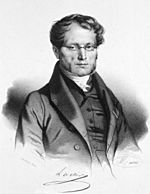Pierre Charles Alexandre Louis facts for kids
Quick facts for kids
Pierre-Charles-Alexandre Louis
|
|
|---|---|

Drawing of Pierre-Charles-Alexandre from Fielding Hudson Garrison's An introduction to the history of medicine
|
|
| Born | 14 April 1787 Ay, Champagne, France
|
| Died | 22 August 1872 (aged 85) |
| Resting place | Montparnasse |
| Nationality | French |
| Citizenship | French |
| Known for | Development of the "numerical method", precursor to epidemiology and the modern clinical trial |
| Scientific career | |
| Fields | Medicine, pathology, epidemiology |
| Institutions | Hôtel-Dieu de Paris, Pitié-Salpêtrière Hospital |
| Influenced | Oliver Wendell Holmes, Sr.; |
Pierre-Charles-Alexandre Louis (born April 14, 1787 – died August 22, 1872) was a French doctor. He was known for his studies on diseases like tuberculosis and pneumonia. His biggest contribution to medicine was creating the "numerical method." This method was an early form of epidemiology and the modern clinical trial. It helped doctors use facts and data to make better decisions about patient care.
Contents
About Pierre Louis
Pierre Louis was born in Ay, a town in France, to a wine merchant family. He grew up during the French Revolution. He first thought about studying law but later chose medicine. He finished his medical studies in Paris in 1813.
Louis married later in life. He had one son, Armand, who sadly died from tuberculosis in 1854. After this, Louis stopped practicing medicine. An American politician, Charles Sumner, described Louis as a "tall man" with a calm face. Louis taught at famous hospitals in Paris, like Hôtel-Dieu de Paris. One of his students was Oliver Wendell Holmes, Sr., a well-known American writer and doctor.
His Medical Training
After graduating, Louis traveled to Russia and later settled in Odessa, a city in Ukraine. He had a successful private medical practice there for four years. The Tsar (the emperor of Russia) even gave him an honorary doctor's title.
However, in 1820, a serious outbreak of diphtheria made him realize he needed to learn more. He returned to Paris and worked at a hospital for seven years. During this time, he collected thousands of patient records. He also performed hundreds of autopsies (medical examinations after death). This detailed work helped him write important studies on diseases like tuberculosis. It also led him to develop his famous "numerical method."
The Numerical Method
Starting in 1823, Pierre Louis began sharing the results of his research. He used numbers and data from his patient studies and autopsies to understand diseases better.
In the 1800s, many doctors believed that fevers were caused by inflammation (swelling) in the body. A common treatment for almost any fever was bloodletting, which meant taking blood from a patient. Louis disagreed with this idea. In 1828, he published a paper that showed bloodletting was not effective for treating pneumonia.
Doctors at the time were often unwilling to change their treatments. They didn't want to wait for tests to see if their methods worked. But slowly, Louis's ideas gained acceptance. Doctors began to see that his "numerical method" brought a more factual approach to medicine. This helped improve how patients were treated.
How the Method Worked
The "numerical method" involved looking at groups of patients with the same illness. Louis would average out the results from these groups. This helped him decide the best way to treat individual patients. He also stressed that patients in different treatment groups should be similar. He considered factors like age, diet, and how severe their illness was.
Louis believed that differences between individual patients would "average out" when looking at a group. However, he didn't fully understand the importance of randomization. This is a way to make sure patient groups are truly similar by chance. Some doctors argued that every patient case was too different to be grouped together. Louis responded by saying that all cases have some things in common. He argued that if every case was unique, medicine could never make progress.
Studying Bloodletting
Louis's first major study using his method looked at bloodletting for pneumonia. He chose 77 patients who had a very similar type of pneumonia. He looked at when their illness started, how long it lasted, and how many died. Then, he analyzed when the bloodletting happened: either early (1–4 days into the illness) or late (5–9 days).
Louis found that patients who had bloodletting early recovered faster. However, they also died at higher rates. Based on this, he concluded that bloodletting was only useful in the later stages of the disease. It's hard to know exactly how much Louis's studies changed medicine. The practice of bloodletting was already starting to decline when he published his findings.
His Lasting Impact
Pierre Louis did other important work that was like early epidemiology. He would divide patients into groups: those who were exposed to something and got sick, versus those who weren't exposed. This helped him find links between illness and its causes. For example, he figured out that emphysema (a lung disease) could be passed down in families.
For his work on the numerical method, Louis was made the permanent president of the Society for Medical Observation. This group was formed by his students. Louis is also given credit for making patient medical histories more organized. He suggested starting with general health questions and then moving to specific symptoms. In 1849, he was made an honorary member of the American Academy of Arts and Sciences.
Louis was a mentor to Oliver Wendell Holmes Sr. when Holmes was studying in Paris. Louis's careful, questioning approach greatly influenced Holmes.
See also
 In Spanish: Pierre Charles Alexandre Louis para niños
In Spanish: Pierre Charles Alexandre Louis para niños

